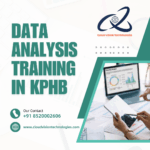Introduction to Python for Data Science:
Python Data Science Course in Hyderabad, It has become the go-to language for data science due to its simplicity, versatility, and extensive ecosystem of libraries. Whether you’re analyzing data, building machine learning models, or visualizing insights, Python provides a seamless and efficient workflow. In this blog, we will explore how Python is used in data science, its key applications, and the essential libraries that make it a powerful tool for data-driven decision-making. Cloud Vision Technologies.
What is Python Data Science?
Python Data Science refers to the use of Python programming for analyzing, processing, and deriving insights from data. It involves collecting, cleaning, visualizing, and applying machine learning techniques to extract meaningful information and make data-driven decisions. Python has become the most popular language for data science due to its simplicity, extensive libraries, and strong community support. Data Science Course in Hyderabad.

Why Use Python for Data Science?
Python has become the most widely used programming language for data science due to its versatility, simplicity, and powerful ecosystem of tools. Whether you’re a beginner exploring data or an expert building complex machine learning models, Python provides the flexibility and efficiency needed to handle vast amounts of data. Here’s why Python is the preferred choice for data science:
Ease of Use and Readability
One of the biggest advantages of Python is its simple and readable syntax, which makes it easy to learn and use. Unlike other programming languages that require complex code structures, Python allows data scientists to focus on problem-solving rather than syntax complexities. Its intuitive nature enables quick prototyping and experimentation, which is essential in data science when dealing with different datasets and algorithms. Data Science Course in Hyderabad.
Additionally, Python’s dynamic typing and minimal boilerplate code make it easier to write and maintain scripts. Even those with little to no programming experience can quickly grasp Python’s fundamentals and apply them to data analysis and visualization. Data Science Course in Hyderabad.
Extensive Libraries for Data Science
Python comes with a vast collection of specialized libraries designed specifically for data science, making tasks such as data analysis, machine learning, and visualization more efficient. Some of the most widely used libraries include:
Extensive Libraries for Data Science with Python
Python stands out in the data science world largely due to its extensive ecosystem of libraries that simplify and accelerate data-related tasks. These libraries offer robust solutions for everything from basic data manipulation to advanced machine learning and deep learning applications. By leveraging these tools, data scientists can efficiently handle massive datasets, perform complex calculations, visualize data trends, and build predictive models.
Pandas: Data Manipulation Made Easy
Pandas is one of the most essential libraries in the Python data science toolkit. It introduces powerful data structures like Series and DataFrames that simplify the process of handling and analyzing structured data. With Pandas, users can easily clean, filter, group, and aggregate data, making it ideal for data preprocessing and exploration. Its intuitive syntax allows even beginners to perform complex data operations quickly and effectively.
NumPy: Foundation for Numerical Computing
NumPy (Numerical Python) is the backbone of numerical and scientific computing in Python. It provides high-performance support for working with large, multi-dimensional arrays and matrices. NumPy also includes a wide range of mathematical functions to perform operations such as linear algebra, Fourier transforms, and random number generation. Most other data science libraries, including Pandas and Scikit-learn, are built on top of or are compatible with NumPy. Python Data Science Course in Hyderabad.
Matplotlib and Seaborn: Data Visualization Tools
Data visualization is key to interpreting results and communicating findings. Matplotlib is a flexible plotting library that lets you create everything from simple line plots to complex multi-panel figures. Seaborn, built on top of Matplotlib, offers a high-level interface for creating attractive and informative statistical graphics. Together, they help data scientists transform raw data into clear, visual insights using bar charts, histograms, scatter plots, and heatmaps. Python Data Science Course in Hyderabad.
Scikit-Learn: Machine Learning Made Accessible
Scikit-Learn is a user-friendly library that provides efficient tools for data mining and machine learning. It includes a wide variety of algorithms for classification, regression, clustering, dimensionality reduction, and model evaluation. Its consistent and simple API allows data scientists to quickly train, test, and tune models, making it a go-to choice for beginners and professionals alike when developing predictive models. Python Data Science Course in Hyderabad.
TensorFlow and PyTorch: Deep Learning Frameworks
For more advanced applications like artificial intelligence and deep learning, TensorFlow and PyTorch are the preferred libraries. TensorFlow, developed by Google, and PyTorch, developed by Facebook, both provide powerful features for building and training neural networks. They support GPU acceleration, automatic differentiation, and scalable model deployment, making them suitable for tasks like image recognition, natural language processing, and time series forecasting. Python Data Science Course in Hyderabad.
Strong Community Support and Resources
Python has a large and active community of developers, data scientists, and researchers who contribute to its continuous improvement. This means that: A wealth of online tutorials, documentation, and forums are available for learning Python. Open-source projects and GitHub repositories provide ready-to-use code and solutions for common data science problems. Python Data Science Course in Hyderabad.
Regular updates and enhancements ensure that Python stays relevant and up-to-date with the latest advancements in data science. The strong community support makes troubleshooting easier, allowing beginners and professionals to seek guidance and improve their skills efficiently. Python Data Science Course in Hyderabad.
Seamless Integration with Other Technologies
Data science projects often require integration with various databases, cloud platforms, and big data technologies. Python excels in this area by offering:
Compatibility with SQL databases like MySQL, PostgreSQL, and MongoDB for data storage and retrieval. Cloud computing support through platforms like AWS, Google Cloud, and Microsoft Azure for scalable data processing. Python Data Science Course in Hyderabad.
Big data frameworks such as Apache Spark and Hadoop, allowing Python to handle large datasets efficiently. This integration capability makes Python ideal for working with real-world data science applications where data is collected from multiple sources and processed on different platforms. Python Data Science Course in Hyderabad.
Scalability and Flexibility
Python is not just limited to small-scale projects; it is also used in enterprise-level data science applications due to its scalability and flexibility. It supports:
Automation of repetitive tasks, reducing the time and effort needed for data preprocessing and analysis. Parallel computing and distributed computing, allowing Python to process large datasets efficiently. Python Data Science Course in Hyderabad.
Cross-platform compatibility, meaning Python code can run on different operating systems with minimal modifications. Python Data Science Course in Hyderabad.

Key Applications of Python in Data Science
Python is a powerful and versatile programming language widely used in data science for everything from data collection to machine learning model deployment. Its rich ecosystem of libraries and frameworks makes it an essential tool for processing, analyzing, and visualizing data. Below are some of the key applications of Python in data science:
Data Collection and Preprocessing:
Before performing any data analysis, the first step is to collect, clean, and structure the data for meaningful insights. Python simplifies this process through:
Data Extraction – Python allows seamless integration with databases (SQL, NoSQL), APIs, and web scraping techniques to extract data from various sources, including websites and online repositories. Libraries like BeautifulSoup and Scrapy help automate the extraction of information from web pages. Python Data Science Course in Hyderabad.
Data Cleaning – Raw data often contains missing values, duplicates, or inconsistencies. Python libraries like Pandas and NumPy help clean and organize data by handling null values, removing outliers, and ensuring uniform data formats. Python Data Science Course in Hyderabad.
Data Transformation – The extracted data needs to be structured into an appropriate format for analysis. Python provides tools for converting categorical data into numerical form, normalizing values, and merging multiple datasets into a single structured dataset. Proper data preprocessing ensures that the dataset is accurate, consistent, and ready for further analysis. Python Data Science Course in Hyderabad.
Exploratory Data Analysis (EDA):
EDA is a critical step in understanding the data before applying complex models. It involves summarizing, visualizing, and identifying key patterns and relationships. Python makes EDA easy through:
Statistical Analysis – Using Pandas and NumPy, data scientists can calculate mean, median, variance, and standard deviation, helping them understand the distribution of data.
Data Visualization – Libraries like Matplotlib and Seaborn enable the creation of informative visualizations, including histograms, scatter plots, and bar charts, helping to detect trends and patterns. Python Data Science Course in Hyderabad.
Outlier Detection – Python helps in identifying anomalies and extreme values that might negatively impact model performance. Techniques like box plots and z-score analysis make it easier to filter out such anomalies. By performing EDA, data scientists gain a deep understanding of the dataset, allowing them to make informed decisions before building models. Python Data Science Course in Hyderabad.
Machine Learning and Predictive Analytics:
Python plays a crucial role in building machine learning models that make predictions based on data. With libraries like Scikit-Learn, TensorFlow, and PyTorch, data scientists can:
Train Machine Learning Models – Python provides pre-built algorithms for classification, regression, and clustering to identify patterns in data. Python Data Science Course in Hyderabad.
Evaluate Model Performance – Using techniques like confusion matrices, precision-recall curves, and cross-validation, Python helps determine the effectiveness of a model.
Optimize and Fine-Tune Models – Hyperparameter tuning and ensemble learning techniques can be applied to improve accuracy and efficiency. Machine learning applications range from predicting stock prices and customer behavior to detecting fraudulent activities in banking systems. Python Data Science Course in Hyderabad.
Data Visualization:
Effective data visualization is essential for communicating insights to stakeholders and decision-makers. Python provides powerful visualization tools, including:
Interactive Dashboards – Libraries like Plotly and Dash allow the creation of interactive visual dashboards that help businesses make real-time data-driven decisions.
Heatmaps and Correlation Matrices – Seaborn enables the visualization of correlations between variables, helping data scientists select the best features for machine learning models. Python Data Science Course in Hyderabad.
Storytelling with Data – Data storytelling through customized charts, graphs, and infographics improves the understanding of trends, distributions, and relationships in data. Visualizing data in an intuitive and easy-to-understand format helps businesses quickly grasp insights and take necessary actions. Python Data Science Course in Hyderabad.
Big Data and Cloud Computing:
As data grows exponentially, Python’s compatibility with big data technologies and cloud computing platforms makes it a valuable tool for large-scale data processing. Python supports:
Big Data Processing – Python integrates with frameworks like Apache Spark and Hadoop, enabling distributed computing to process massive datasets efficiently.
Cloud-Based Machine Learning – Platforms like Google Cloud AI, AWS SageMaker, and Microsoft Azure ML allow the deployment and scaling of machine learning models in the cloud. Python Data Science Course in Hyderabad.
Enterprise-Scale Applications – Python’s ability to handle large-scale data pipelines ensures seamless operation for businesses and industries that rely on real-time analytics. By leveraging big data and cloud technologies, organizations can scale their data science solutions and optimize performance for faster and more efficient decision-making.
Essential Python Libraries for Data Science
Python’s strength in data science comes from its vast ecosystem of specialized libraries that streamline everything from data manipulation and visualization to machine learning and deep learning. Below are some of the most essential Python libraries for data science and their key applications. Python Data Science Course in Hyderabad.
Pandas – Data Manipulation and Analysis:
Pandas is one of the most widely used libraries for handling and analyzing structured data. It provides powerful data structures such as Series and DataFrames, making it easy to manipulate large datasets efficiently. With Pandas, data scientists can:
Load data from various sources, including CSV, Excel, SQL databases, and JSON files. Clean and preprocess data by handling missing values, removing duplicates, and performing transformations. Perform data aggregation, grouping, and filtering to extract meaningful insights. Merge and join multiple datasets seamlessly. Python Data Science Course in Hyderabad.
Pandas serves as the backbone of data science workflows, enabling quick data exploration and preparation before advanced analysis. Python Data Science Course in Hyderabad.
NumPy:
NumPy (Numerical Python) is a fundamental library for numerical computing, providing support for multi-dimensional arrays and mathematical functions. It is known for its high-speed operations, which are crucial for handling large datasets efficiently. Key features of NumPy include:
N-Dimensional Arrays (n-darray) – Provides a flexible and memory-efficient way to store and manipulate large datasets. Python Data Science Course in Hyderabad.
Mathematical Functions – Offers a wide range of functions for linear algebra, statistical calculations, and complex mathematical operations. Python Data Science Course in Hyderabad.
Broadcasting – Enables element-wise operations on arrays of different shapes, reducing the need for loops and improving performance. NumPy is often used alongside Pandas and Scikit-Learn, forming the foundation of many data science and machine learning tasks.

Matplotlib & Seaborn – Data Visualization:
Data visualization is a crucial aspect of data science, helping to communicate insights effectively. Matplotlib and Seaborn are two powerful libraries used to create graphs, charts, and statistical plots. Python Data Science Course in Hyderabad.
Matplotlib – Provides a low-level, flexible framework for creating a wide range of static, animated, and interactive plots. It allows customization of plots with labels, colors, and styles. Python Data Science Course in Hyderabad.
Seaborn – Built on top of Matplotlib, Seaborn simplifies the creation of statistical visualizations such as histograms, box plots, heatmaps, and pair plots. It is particularly useful for detecting trends, correlations, and outliers. These libraries are essential for exploratory data analysis (EDA), helping data scientists interpret data visually before applying machine learning techniques. Python Data Science Course in Hyderabad.
Scikit-Learn – Machine Learning and Model Evaluation:
Scikit-Learn is the go-to library for machine learning in Python. It provides a comprehensive set of tools for building and evaluating machine learning models, including:
Supervised Learning Algorithms – Supports classification (e.g., Decision Trees, Support Vector Machines) and regression (e.g., Linear Regression, Random Forest).
Unsupervised Learning Techniques – Includes clustering algorithms like K-Means and DBSCAN for pattern recognition and anomaly detection. Python Data Science Course in Hyderabad.
Feature Selection and Preprocessing – Provides methods for scaling, normalizing, and encoding data before feeding it into models. Python Data Science Course in Hyderabad.
Model Evaluation – Includes cross-validation, confusion matrices, and performance metrics to assess model accuracy. Scikit-Learn is widely used in industries ranging from finance and healthcare to marketing and customer segmentation. Python Data Science Course in Hyderabad.
TensorFlow & PyTorch – Deep Learning and AI Applications:
Deep learning has revolutionized data science, and Python offers two leading frameworks for building neural networks and AI-driven applications:
TensorFlow (by Google) – A powerful framework for training and deploying deep learning models. It supports both CPU and GPU computing, making it highly scalable. TensorFlow is commonly used for image recognition, natural language processing (NLP), and reinforcement learning. Python Data Science Course in Hyderabad.
PyTorch (by Facebook) – Known for its dynamic computation graph and ease of debugging, PyTorch is popular among researchers and deep learning practitioners. It is widely used in academic research, medical imaging, and autonomous systems.
BeautifulSoup & Scrapy – Web Scraping and Data Extraction:
Data scientists often need to extract data from web pages, online databases, and APIs. Python simplifies web scraping through libraries like BeautifulSoup and Scrapy:
BeautifulSoup – A lightweight library that parses HTML and XML documents, allowing users to extract data from web pages easily. It is commonly used for scraping structured data from tables, articles, and online repositories. Python Data Science Course in Hyderabad.
Scrapy – A more advanced web scraping framework that enables automated crawling of websites and data extraction. It is highly efficient for handling large-scale scraping tasks and integrating with databases. These libraries are widely used in industries such as market research, news aggregation, and e-commerce analytics, where real-time data extraction is essential. Python Data Science Course in Hyderabad.
The Future of Python in Data Science
Python’s role in data science continues to expand with advancements in artificial intelligence, cloud computing, and big data analytics. Future developments in automation, real-time analytics, and AI-driven insights will further enhance Python’s capabilities in data science. Python Data Science Course in Hyderabad.
As businesses and industries increasingly rely on data-driven decision-making, Python will remain a dominant force in shaping the future of data science. Whether you’re a beginner or an experienced data scientist, learning Python can open doors to exciting career opportunities in this rapidly growing field. Python Data Science Course in Hyderabad.
Python Data Science Course in Hyderabad
Hyderabad has become a prominent hub for tech and data-driven careers, making it an ideal location to pursue a Python Data Science course. With the city’s growing demand for skilled data professionals in sectors like IT, finance, healthcare, and e-commerce, learning Python for data science can open doors to numerous job opportunities. Whether you’re a beginner, a graduate, or a working professional aiming to transition into data roles, Hyderabad offers a supportive learning environment with a rich tech community. Python Data Science Course in Hyderabad.
The course typically covers essential Python programming basics, data manipulation using Pandas and NumPy, data visualization with Matplotlib and Seaborn, statistical analysis, machine learning algorithms, and real-world projects. Institutes also include tools like Jupyter Notebook, Scikit-learn, and basics of SQL, ensuring learners gain hands-on experience. Some reputed institutes in Hyderabad provide both online and offline training options, weekend batches for working professionals, and placement assistance as part of the package. Python Data Science Course in Hyderabad.

Conclusion
Python has revolutionized data science by providing a powerful, flexible, and user-friendly environment for analyzing and interpreting data. Its extensive library support, ease of use, and scalability make it an essential tool for data professionals. As the demand for data-driven insights grows, mastering Python for data science will be a valuable skill in today’s technology-driven world. Python Data Science Course in Hyderabad.
Address: Cloud Vision Technologies
Location: Samhitha Enclave, 3rd floor, KPHB Phase 9, Kukatpally, Hyderabad, Telangana – 500072
Contact Number : +91 8520002606
Mail ID: info@cloudvisiontechnologies.com
Website: https://www.cloudvisiontechnologies.com



